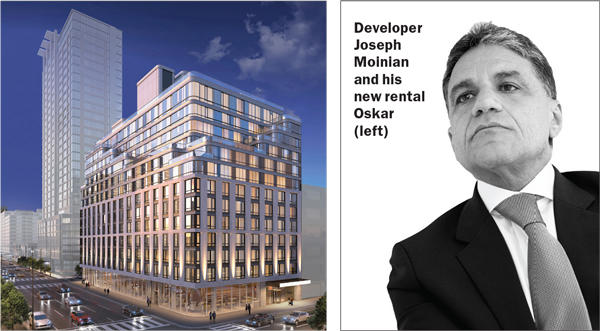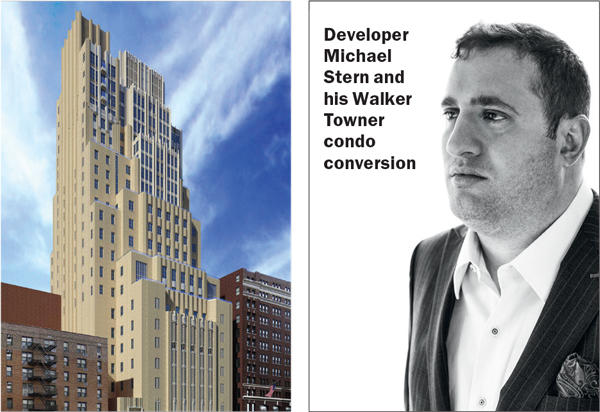Trending
Alexa, upgrade my technology
For NYC developers, ponying up for high-tech apartments can backfire — in an expensive way

It seemed like a good idea at the time.
In 2012, when the Rabsky Group developed 225 North 9th Street, a luxury rental in Williamsburg, it installed built-in iPod docks in all 34 apartments.
But a few months later, that idea didn’t seem quite as cutting-edge. Apple released a new version of the iPod with a plug that was incompatible with the older docks. Renters with iPod Touches — as quaint as that sounds — were out of luck.
And years later, there still doesn’t seem to be any clear consensus about how to fix the problem.
“We encourage our tenants to use adapters, to use the existing iPod docks, while we work on a more permanent solution to eventually replace them,” said an employee of Goose Property Management, the building’s manager, who only identified herself as Pearl G., in an email.
The Rabsky Group did not respond to a request for comment, but the firm is clearly not alone.
In an era when devices are being upgraded by the minute and new ones are being regularly unveiled, developers across the city have learned the hard way that hardwiring buildings for specific technology can backfire, according to condo sponsors, brokers and property managers.
Not only does incorporating technology into buildings costs millions of dollars (at least in the highest-end buildings), it can go obsolete fast.
“Real estate moves a lot slower than technology,” said developer Michael Stern, whose JDS Development Group spent $25,000 to upgrade outdated tech at its condo conversion Walker Tower a few years ago.
While low-cost fixes are sometimes possible (think adapters), in other cases, particularly in large developments, it could cost developers hundreds of thousands of dollars, or more, to modernize a music system or deal with issues involving lights, shades, security systems and other automated systems, according to IT consultants.
Condo developers are generally less financially exposed on this front because once they sell a unit, they’re no longer on the hook. But at a time when units have lingered on the market — according to a second-quarter report from Douglas Elliman, the Manhattan absorption rate jumped year over year to eight months from six — there’s an increased risk that the next big thing will launch before a developer unloads units.
Still, offering plans for condos are often extremely specific — spelling out everything from the model number to the color of the devices.
“If a developer chooses to provide a different make and model due to a change in technology, our office’s regulations require that the developer amends the plan promptly” to make certain that “equal or better quality” items are substituted, according to a statement from the Real Estate Finance Bureau of the state attorney general’s office, which approves offering plans.
But “developers generally detail with a fair amount of specificity exactly what they are providing, so they will be protected regardless of whether the technology becomes defunct,” the statement continued.

With that said, Stephen Kliegerman, the president of Terra Development Marketing — the parent company for Brown Harris Stevens Development Marketing and Halstead Property Development Marketing — noted that developers don’t want to “marry themselves to a specific type of system.” Bells and whistles, he said, don’t even necessarily add a premium to the list price.
“These projects can be planned five years in advance, which means the technology could be a little stale by the time we deliver,” he said.
Has the Apple lost its shine?
At Walker Tower, which sits at 212 West 18th Street in Chelsea, JDS admittedly got caught flat-footed.
Like Rabsky’s Williamsburg rental, the Verizon tower-turned-luxury condo, where the planning began in 2010, included built-in iPod and iPad docks in every apartment. The approval of the offering plan in 2011 locked in those finishes.
But as sales began, Apple changed its plug sizes, so those who moved into Walker Tower with upgraded iPhones found the outlets useless.
Starting in 2012, with about a quarter of the units in contract, the developers began swapping out docks to appeal to potential buyers. The $25,000 upgrade was contained to about a dozen of the 49 units, largely because some buyers were doing work to their apartments and ate the costs.
The experience taught Stern a lesson: “We now let buyers put in their own devices because whatever you install, you wait two years, it’s outdated.”
And it’s not just the visible tech, said Yoel Sabel, a vice president at Brooklyn developer Halcyon Management Group.
At 101 Bedford Avenue, a 351-unit rental in Williamsburg developed in 2010, Sabel said Halcyon is now spending $500,000 to replace the electronic card readers (the software became defunct) for the locks on 60 doors in the building’s common spaces and to add security cameras. The upgrade is expected to last four months.
“And you can’t even sell it,” Sabel said. “The tenant can’t understand what it is, because they don’t touch it.”
Jason Madlin, the owner of Smart Spaces Group, an IT firm that consults with apartment owners and developers — Toll Brothers is a client — said buyers and renters have upped their expectations with time. For example, they now expect to be able to control everything from temperature to lighting while walking around (or even remotely).
Madlin also said that the long-time go-to brand for home automation systems — Crestron — is increasingly being replaced by more “agnostic” systems that can handle a range of devices.
At 88 Greenwich Street, a roughly 450-unit prewar condo in the Financial District that was co-developed by Buttonwood Real Estate and Thor Equities in 2007, many of the units still include iPod and iPad docks that pump music through built-in speakers, according to brokers and reviews of listings.
Those units have all been unloaded by the developers and are now resales. And brokers who have listings there have managed to downplay the outdatedness — even in today’s Bluetooth age.

“The system has versatility,” and it’s fairly easy to switch over to a non-iPad stereo option, said Prince Dockery, an associate broker with Compass who had five units for sale at 88 Greenwich in mid-September, priced from $649,000 to $1.7 million. “The developers were pretty smart about it.”
Those unused docks, which are about midway up the walls, have barely put a dent in sales, he said. “I know people who cover them up with paintings,” he added. “Really big ones.”
Alternatively, condo boards could collectively decide to remove the unwanted hardware. In the lowest-cost approach, experts said, a technician might remove the docks, followed by a contractor plastering and painting the walls. Then the technician could install a new server in a closet and connect it to the existing speakers.
That kind of bare-bones job might cost $1,000 per unit. If a condo the size of 88 Greenwich undertook a basic upgrade of its sound systems, it could be on the hook for a couple hundred thousand dollars, according to consultants.
“It’s a major project,” Madlin said.
Going low-tech
During the planning of the 164-unit rental known as Oskar, the Moinian Group considered including USB ports in the kitchen walls.
The idea was to allow tenants in the Hell’s Kitchen building, which opened in June, to more easily charge their phones.
But in the end, the firm, which is headed by Joseph Moinian, opted against it.
“We were worried that the size of USB ports would someday change,” said Natasha Vardi, a senior vice president at Moinian. “Stuff like that we stayed away from.”
Vardi also nixed LED screens for the lobby and smart appliances, despite being intrigued by them at a trade show this year. A voice-activated control system like Amazon’s Echo was also left on the cutting room floor.
“It is of the moment, but we wondered, will it change?” Vardi said. “Will a new one come out that is even better? Will it hold the test of time? Not even 10 years, but a couple years?”
Other developers have gone a different route.
At 88 and 90 Lexington Avenue — a 100-plus-unit condo where listings are priced up to just over $6 million — HFZ Capital Group included a four-port USB outlet in each unit, a spokeswoman said.

And despite the risks, others aren’t shying away from spending on tech, either.
Adam America Real Estate is embracing smart kitchens at Five Six One Pacific, a 63-unit condo under development in Boerum Hill where sales begin next year. Ovens there can be turned on and off remotely; refrigerators can be similarly adjusted.
Meanwhile, at RXR Realty’s 475 Clermont Avenue, a new 363-unit rental in Clinton Hill, Brooklyn, renters will be able to lock their front doors with their smartphones, courtesy of locks by the five-year-old company Latch. And the startup has buy-in from some major industry heavyweights: Both Tishman Speyer and Brookfield Ventures — Brookfield Asset Management’s VC division — just helped bankroll its $70 million Series B round of venture capital financing.
But perhaps the boldest move is at Quay Tower, a 30-story condo being constructed in Brooklyn Bridge Park by RAL Companies and Oliver’s Realty Group.
It’s aiming to be one of New York’s first all-voice-automated condos, where each of the 126 apartments will be outfitted with Echo devices in living rooms and smaller Echo Dots in bedrooms, allowing residents to control everything from heat to lights. (The developers said buyers can opt out, and noted that the Nest thermostats also have manual dials.)
“A lot of developers are scared off after what happened with the iPod. And some tech gadgets don’t look as elegant as they should in some buildings,” said Joshua Wein, RAL’s financial director.
To ease buyers’ concerns, RAL has hired a full-time Amazon-savvy consultant to install the Echos and troubleshoot problems, Wein said. In addition, Amazon has offered 120 days of free phone support from the moment the building receives its temporary certificate of occupancy, he added.
“We didn’t want it to become a headache for anyone,” Wein said.
But it’s hard to know how buyers will react to a heavy Alexa presence. A spokesperson declined to share sales figures for the condo, which began marketing in June at about $2,000 per square foot. Quay Tower is supposed to open in fall 2019.
Some brokers are wary of voice devices, citing security concerns.
Halstead’s Kliegerman recalled an incident in which a couple was talking about a product, oblivious to the fact that they were being recorded by Alexa. When the couple later logged on to Facebook, they were flooded with ads for the product.
Wein has heard similar stories. “Privacy is definitely a concern,” he said. But, he said, at Quay “there is no listening unless a device is activated with the word ‘Alexa.’”
Moinian’s Vardi pointed out that while the tech may be enticing, it won’t do much to lure in buyers if the actual units are not up to par.
“Tech is the sprinkles that you put on top of your cake,” she said. “It’s not the ingredients of the cake itself. You need to have the rest of everything in place.”




